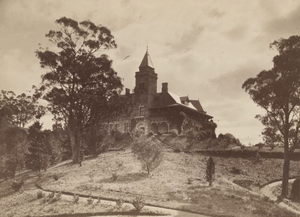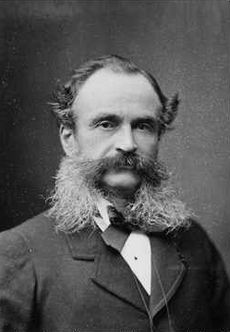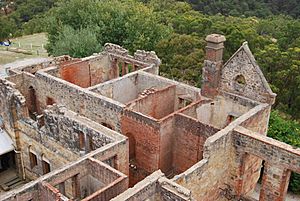Marble Hill, South Australia facts for kids
Quick facts for kids Marble HillSouth Australia |
|||||||||||||||
|---|---|---|---|---|---|---|---|---|---|---|---|---|---|---|---|

Ruins of the Governor's summer residence, showing the restored tower.
|
|||||||||||||||
| Established | 1879 | ||||||||||||||
| Postcode(s) | 5137 | ||||||||||||||
| Elevation | 615 m (2,018 ft) | ||||||||||||||
| Location | 14 km (9 mi) from Adelaide | ||||||||||||||
| LGA(s) | Adelaide Hills Council | ||||||||||||||
| State electorate(s) | Morialta | ||||||||||||||
| Federal Division(s) | Mayo | ||||||||||||||
|
|||||||||||||||
Marble Hill was a special summer home for the Governor of South Australia. It was used for 75 years, from 1880 to 1955. Today, 'Marble Hill' is also the name of a local area and a suburb, both named after this historic house. It's about 20 kilometres (12 mi) east of Adelaide, located between the towns of Ashton and Cherryville. From here, you can see amazing views of the Adelaide Hills and the Adelaide Plains.
Sadly, a big bushfire called the Black Sunday bushfire destroyed the house in 1955. After the fire, different groups like the National Trust of South Australia and the Department for Environment and Heritage looked after the site. A group of volunteers, the Friends of Marble Hill, also helped out.
The main building has never been fully rebuilt. However, the National Trust did restore the tower and the nearby stables in the 1970s. Rebuilding the whole house would be very expensive, so the government decided not to use public money for it. In 2009, a local family bought Marble Hill. They plan to rebuild and use the house again.
Contents
History of Marble Hill
The area around Marble Hill was not very developed until the summer residence was built. Before 1880, it was mostly wild land used for grazing animals. It was hard for settlers to live there because the land was rough, and the government didn't sell much of it.
In 1878, a large area became a government reserve, and building started on the residence. It's said that Governor William Jervois named the hill around this time. When he heard that "marble" was found during digging, he said, "Then we shall call it Marble Hill." But actually, there's no real marble there! The person who told the Governor had mistaken a common local rock called quartzite for marble. Another story says it was named because the hill's round top looked like a marble from far away.
Later, in 1896, some of the government land was divided into smaller blocks. People who lived on these blocks, called "blockers," found it tough to start with. But by the 1920s, all the blocks were used and growing fruit trees. Before the government reserve, part of the area was used as a shelter for lost animals.
Who Lived at Marble Hill?
The first country home for the Governor was built in 1860 at Belair National Park. But it was too small for some governors. When Governor William Jervois arrived in 1877, he quickly suggested building a new, grander house. He helped get money from the government and chose the site himself. The first stone was laid on July 18, 1878, and the house was finished in late 1879. Even though it cost more than planned, politicians were impressed by how magnificent it was.
The architect, William McMinn, designed the house in a Victorian Gothic Revival style. He added large verandahs on three sides to protect the house from the hot Australian sun. His plan was for 40 rooms, but only 26 were built. The main rooms included a drawing room, a morning room, a dining room, and a grand staircase made of kauri pine and blackwood wood. It wasn't built for huge parties, but as a cool escape from Adelaide's summer heat. The sandstone used to build it came from local quarries. Stables and a caretaker's cottage were also built nearby.
Governors and Their Stays
All 15 governors who served from 1880 to 1955 spent time at Marble Hill. Many important guests visited, including King George V and Queen Mary (when they were the Duke and Duchess of Cornwall and York) in 1901. Governors also often invited local children and groups for tours.
- 1880–1883: William Jervois – Governor Jervois was very friendly with local people and helped raise money for community projects.
- 1883–1889: William Robinson – Sir William found Marble Hill a bit lonely and often wanted to be somewhere else, like by the sea.
- 1889–1895: Algernon Keith-Falconer – Lord and Lady Kintore visited regularly and had the gardens designed.
- 1895–1899: Thomas Buxton – Buxton hosted a garden party for over 100 delegates of the Federal Convention in 1897.
- 1899–1902: Hallam Tennyson – Sir Hallam and Lady Audrey Tennyson loved Marble Hill, even with the heat, drought, and bushfires. They even thought about buying it later.
- 1903–1909: George Le Hunte – Local children looked forward to the LeHuntes' yearly visits because the Governor often held fun events for them.
- 1909–1914: Day Bosanquet – Lady Bosanquet continued inviting local schoolchildren, hosting a "Picnic at Marble Hill" every year.
- 1914–1920: Henry Galway – Galway stayed at Marble Hill for four of his six summers. In 1916, he offered it as a military hospital, but it was considered too far away.
- 1920–1922: Archibald Weigall – Governor Weigall loved cricket. He held an annual match between his guests and locals at the nearby Ashton Oval.
- 1922–1927: Tom Bridges – Governor Bridges only used Marble Hill for occasional weekends. The government thought about selling it because it cost money to run.
- 1928–1934: Alexander Hore-Ruthven – Marble Hill became less popular. The Governor said he would give up using it, but it was hard to find staff or change it into a government building.
- 1934–1939: Winston Dugan – Some changes were made in 1939, like adding more bathrooms and turning the old coach-house into a garage for cars.
- 1939–1944: Malcolm Barclay-Harvey – During World War II, Sir Malcolm and Lady Muriel Barclay-Harvey spent time at Marble Hill when they could. They fixed up the beautiful gardens, and Sir Malcolm, who loved trains, even had a model railway outside.
- 1944–1952: Willoughby Norrie – Governor Norrie and his family moved into Marble Hill as soon as they arrived in Adelaide and stayed there every summer. Lady Norrie hosted Lady Baden-Powell, the World Chief Guide, in 1948.
- 1952–1955: Robert George – In 1954, the government started renovating the Governor's homes. The old gas lighting at Marble Hill was replaced with electricity, which was very expensive. Sir Robert and Lady George's belongings were moved to Marble Hill while their main home was being fixed after an earthquake. Marble Hill was next for renovations.
Bushfires and Destruction
Marble Hill was located on top of a steep, wooded ridge, which meant bushfires were a constant danger.
Fires Over the Years
- 1882 – Just two years after it was finished, Marble Hill was first threatened by a bushfire. Police and locals worked quickly to stop it, but the garden and some fences were damaged.
- 1901 – Hot, dry weather caused many bushfires while Sir Hallam and Lady Tennyson were there. Lady Tennyson wrote that the fires were an amazing sight at night. The gardens and part of the orchard were damaged.
- 1910 – Bushfires threatened Marble Hill. Governor Bosanquet helped firefighters and volunteers create firebreaks. The house was saved, but most of the government land around it burned.
- 1912 – Governor Bosanquet had to defend the house again. A fire started and was driven towards Marble Hill by strong winds. The English cricket team and Lord Richard Nevill arrived for lunch and helped fight the flames. The servant's quarters, caretaker's cottage, stables, and even the kitchen caught fire, but were quickly put out. The gardens, however, were destroyed.
- 1930 – About 100 acres (0.40 km2) of forest next to the house burned. The Governor and staff managed to stop the fire halfway up the driveway.
- 1939 – Marble Hill was again threatened by the Black Friday fires.
- 1955 – The Black Sunday bushfires completely destroyed Marble Hill on January 2.
- 2000 – A controlled burn by firefighters got out of control and became a major fire near Marble Hill.
The Day Marble Hill Was Destroyed
On January 2, 1955, 15 people were at Marble Hill, including Sir Robert and Lady George, their family, and staff. It was extremely hot, 36 °C (97 °F) by 7 am. By 1 pm, it was 42 °C (108 °F), and winds of up to 70 kilometres per hour (43 mph) were pushing a bushfire from nearby Anstey's Hill towards Marble Hill.
With little warning, strong winds pushed the fire up the hill, and flames touched the building. The bitumen on the balcony and seaweed insulation in the roof caught fire easily, and the house was quickly ablaze. The Governor, his sons, and staff tried to save the building, but their buckets and hoses were not enough. The house was swallowed by flames incredibly fast.
The bushfire surrounded the house, cars were burning, and melted lead rained down from the roof. Escaping seemed impossible. Sir Robert told everyone to run out of the house to the safety of a retaining wall by the driveway. They sheltered under wet blankets as the fire swept over them, completely destroying the house. After about two hours, rescuers reached them, and they were taken to Adelaide for treatment of minor injuries. Later, they found that a servant's cat had also survived by hiding in the cellar.
All of the Governor's belongings were lost in the fire. They had been moved to Marble Hill while Government House was being fixed after an earthquake. Marble Hill was supposed to be renovated next, but its destruction made the Government of South Australia change its plans.
Marble Hill as a Ruin
Because it was too expensive to rebuild, the government announced in September 1955 that Marble Hill would not be restored. More damage happened when the government tore down parts of the building considered "unsafe" a few days after the fire.
In 1967, the property was given to the National Trust of South Australia as a public reserve. In 1973, restoration work began on the stables, coach house, and coachman's cottage. The National Trust reopened Marble Hill as a ruin in 1975. In 1979, the tower was rebuilt. In 1980, Marble Hill was added to the South Australian Heritage Register.
During the 1980s, the Country Fire Service used the tower as a bushfire lookout. In 1992, the National Trust closed the site to the public because of a lack of money. The site then went back to the Department of Environment and Heritage (DEH). The next year, the government asked for ideas on how to develop and manage the site. The Mayor of East Torrens suggested rebuilding it as a "VIP hotel."
In 1994, a volunteer group called "Friends of Marble Hill" was formed. They helped with public access, open days, and events. The DEH was responsible for maintenance. The Friends group stopped working when the property was put up for sale in 2007.
Rebuilding Marble Hill
In March 2007, the South Australian government again asked for ideas for the future of Marble Hill. In October 2009, a local couple, Edwin Michell and Dr. Patricia Bishop, bought the property. They have been involved in restoring several historic homes in the Adelaide Hills.
Part of the agreement for buying the property is that the ruin will be rebuilt with the help of a heritage architect. Also, public open days will continue. The work focuses on using local suppliers and traditional building skills. The first part of the rebuilding was finished in December 2015, when a 7-tonne (15,000 lb) copper-roofed tower lantern was installed. The second phase of the project is still ongoing.
Images for kids
See also
 In Spanish: Marble Hill (Australia) para niños
In Spanish: Marble Hill (Australia) para niños









